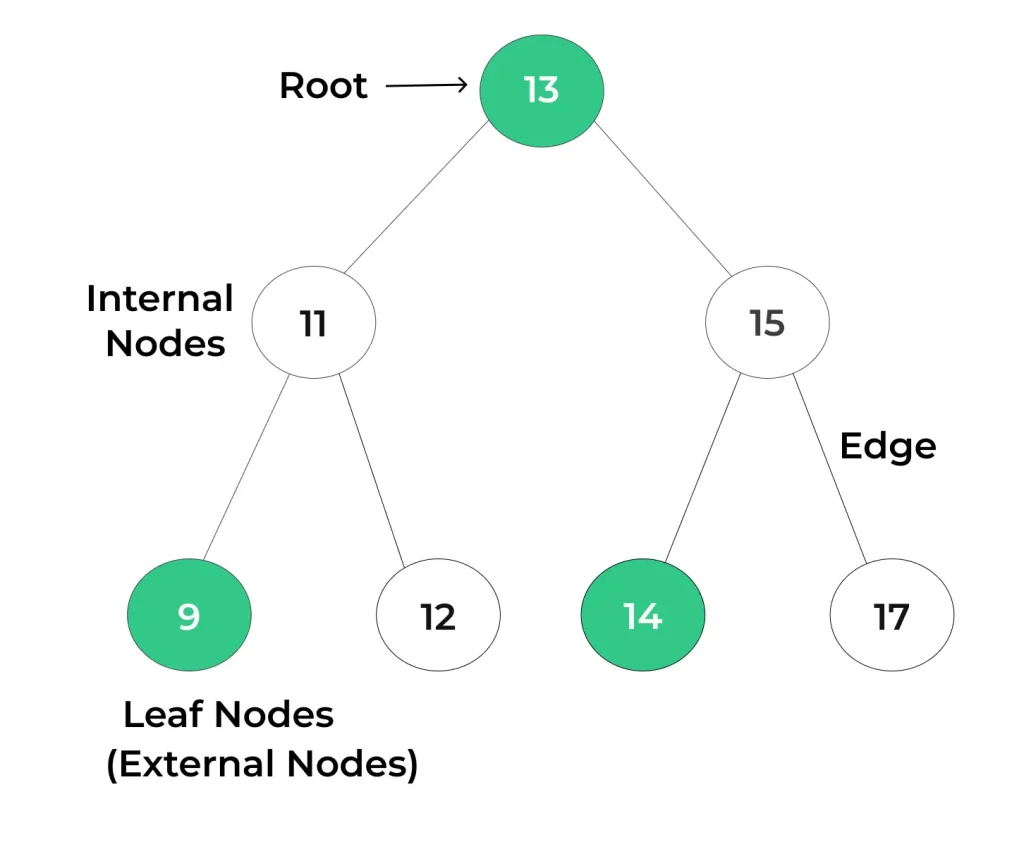Tree Data Structure in Python

Introduction to Tree Data Structure and Algorithm
The Tree Data Structure in Python is a fundamental concept in computer science and programming, offering an elegant way to organize and represent hierarchical relationships. In Python, you have the flexibility to create and manipulate tree structures for various applications.
Let’s jump into the article to know more about Tree Data Structure and also you will get to know about Binary Tree.
Key Terminologies of Tree Data Structures
Tree data structures are a fundamental part of computer science and are widely used in areas like databases, file systems, and searching algorithms. Understanding the key terms associated with trees is essential for mastering topics like Binary Trees, Binary Search Trees, Heaps, and more.
- Node: A fundamental unit of a tree that holds data; every element in a tree is a node.
- Root: The topmost node in a tree that has no parent; every tree has only one root.
- Edge: A link connecting two nodes, showing the relationship between parent and child.
- Parent & Child: A parent is a node with children, and a child is directly connected to its parent.
- Leaf (External Node): A node with no children; it marks the end of a branch.
- Subtree: A smaller tree formed from any node and all its descendants.
Example of Tree Data Structure in Python

What is a Node?
A node in a tree data structure represents an element that stores:
- Data: The actual value stored in the node.
- Pointers/References: Links to its child nodes.
class Node: def __init__(self, data): self.data = data self.children = []
Structure of Node in Binary Tree
The structure of a node in a Binary Tree typically consists of several components:
Data/Value: This is the primary information or content stored in the node. It represents the actual data or value associated with the node, which can be of any data type depending on the application.
Left Child Reference: This reference or pointer points to the left child node of the current node. In a binary tree, a node can have at most one left child.
Right Child Reference: Similar to the left child reference, this pointer points to the right child node of the current node. In a binary tree, a node can have at most one right child.

Implementing Tree Data Structure in Python
Implementing binary trees in Python typically involves defining node and tree classes. Here’s a basic example of a binary tree node and its associated tree:
class TreeNode:
def __init__(self, data):
self.data = data
self.left = None
self.right = None
class BinaryTree:
def __init__(self, root):
self.root = TreeNode(root)
Common Types of Tree Data Structure in Python
Binary Tree
A binary tree is a tree structure where each node has at most two children, often referred to as the “left” and “right” child.
Binary Search Tree (BST)
A binary search tree is a binary tree with the property that the left subtree of a node contains only nodes with values less than the node’s value, and the right subtree contains only nodes with values greater than the node’s value.
AVL Tree
An AVL (Adelson-Velsky and Landis) tree is a self-balancing binary search tree in which the heights of the two child subtrees of every node differ by at most one.
Red-Black Tree
A red-black tree is another self-balancing binary search tree with constraints on color-coded nodes to ensure balance and efficient operations.
Trie
A trie (pronounced “try”) is a tree-like data structure used for efficiently storing a dynamic set of strings, often used in dictionary and autocomplete applications.
B-Tree
A B-tree is a self-balancing tree data structure that maintains sorted data and allows for efficient insertions, deletions, and search operations. It is commonly used in databases and file systems.
Complexity Analysis of Tree in Python
Here, we’ll provide a general overview of the complexity analysis for common tree operations:
Binary Trees:
- Space Complexity: The space complexity of a binary tree is O(n), where n is the number of nodes. Each node requires memory for its data and two references (left and right children).
- Time Complexity:
- Searching (in an unbalanced binary tree): O(n) in the worst case, as it may require traversing all nodes.
- Searching (in a balanced binary search tree like AVL or Red-Black Tree): O(log n) in the average case, thanks to the balanced structure.
- Insertion and Deletion (in an unbalanced binary tree): O(n) in the worst case, as it may require traversing all nodes.
- Insertion and Deletion (in a balanced binary search tree): O(log n) in the average case due to tree balancing.
- Time Complexity:
- Searching: O(log n) in the average and worst case due to balancing.
- Insertion and Deletion: O(log n) in the average and worst case due to balancing. Balancing operations (rotations) can take additional time.
- Space Complexity: O(n), where n is the number of nodes.
To Wrap it up:
We explored the fundamental concepts of trees, where nodes and edges weave intricate hierarchical relationships. The binary tree, with its left and right children, formed the foundation for more specialized structures. Binary Search Trees (BSTs) introduced order and efficiency into our data storage and retrieval methods. AVL Trees and Red-Black Trees demonstrated the art of self-balancing for optimized operations.
Learn DSA
Prime Course Trailer
Related Banners
Get PrepInsta Prime & get Access to all 200+ courses offered by PrepInsta in One Subscription
FAQs
He main difference lies in the ordering of elements. In a binary tree, nodes can have any arrangement, while in a BST, the left subtree of a node contains elements less than the node’s value, and the right subtree contains elements greater than the node’s value.
You can create a binary tree in Python by defining classes for nodes and the tree itself, where each node contains data and references to its left and right children.
Trees are used in file systems, databases, expression parsing, decision-making processes, machine learning (decision trees), and more.
Trees are a specific type of graph with no cycles, where each node has a parent-child relationship. In contrast, graphs can have cycles and arbitrary connections between nodes.

Question 1.
What is the difference between a binary tree and a binary search tree (BST)?
he main difference lies in the ordering of elements. In a binary tree, nodes can have any arrangement, while in a BST, the left subtree of a node contains elements less than the node’s value, and the right subtree contains elements greater than the node’s value.

Question 2.
How do I implement a binary tree in Python?
You can create a binary tree in Python by defining classes for nodes and the tree itself, where each node contains data and references to its left and right children.

Question 3.
What are the common applications of tree data structures in Python?
Trees are used in file systems, databases, expression parsing, decision-making processes, machine learning (decision trees), and more.

Question 4.
What is the difference between a tree and a graph in Python?
Trees are a specific type of graph with no cycles, where each node has a parent-child relationship. In contrast, graphs can have cycles and arbitrary connections between nodes.
Get over 200+ course One Subscription
Courses like AI/ML, Cloud Computing, Ethical Hacking, C, C++, Java, Python, DSA (All Languages), Competitive Coding (All Languages), TCS, Infosys, Wipro, Amazon, DBMS, SQL and others




Login/Signup to comment